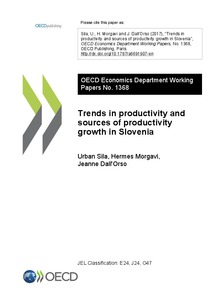Trends in productivity and sources of productivity growth in Slovenia
"Slovenia’s living standards measured in GDP per capita are currently some 20% below the EU15 average and have not yet reached their pre-crisis level. Given that most of this gap comes from differences in labour productivity, the paper looks at productivity trends and sources of productivity gr...
| Main Authors: | , , |
|---|---|
| Institution: | ETUI-European Trade Union Institute |
| Format: | TEXT |
| Language: | English |
| Published: |
Paris
2017
OECD |
| Subjects: | |
| Online Access: | https://www.labourline.org/KENTIKA-756912457419-Trends-in-productivity-and-sou.htm |
| _version_ | 1771659902813470720 |
|---|---|
| author | Sila, Urban Morgavi, Hermes Dall'Orso, Jeanne |
| author_facet | Sila, Urban Morgavi, Hermes Dall'Orso, Jeanne |
| collection | Library items |
| description | "Slovenia’s living standards measured in GDP per capita are currently some 20% below the EU15 average and have not yet reached their pre-crisis level. Given that most of this gap comes from differences in labour productivity, the paper looks at productivity trends and sources of productivity growth over past two decades. The largest labour productivity lags are in agriculture and mining and utilities, but lags are also present in services sectors such as information and communication activities, financial and insurance activities and professional services. The importance of the high and medium high technology manufacturing has risen in the last two decades, and their share in total manufacturing value added is relatively high in Slovenia. Growth accounting shows that total factor productivity (TFP) and physical capital were the main sources of economic growth before the crisis in Slovenia, while the contribution of human capital was low. With the crisis, however, the GDP growth turned highly negative due to large drops in TFP and the labour input contribution. The contribution from physical capital was also reduced, reflecting subdued investment activity. Slovenia has a high level of state control in the economy and low foreign direct investment (FDI). Using two different panel datasets – one spanning the OECD countries and another spanning Slovenia's economic activities - we find that improving both measures could significantly raise productivity." |
| format | TEXT |
| geographic | Slovenia |
| id | 756912457419_d17d652c8a154f45a311407a9172e0ce |
| institution | ETUI-European Trade Union Institute |
| is_hierarchy_id | 756912457419_d17d652c8a154f45a311407a9172e0ce |
| is_hierarchy_title | Trends in productivity and sources of productivity growth in Slovenia |
| language | English |
| physical | 28 p. Digital |
| publishDate | 2017 |
| publisher | Paris OECD |
| spellingShingle | Sila, Urban Morgavi, Hermes Dall'Orso, Jeanne foreign investment productivity research and development Trends in productivity and sources of productivity growth in Slovenia |
| thumbnail | https://www.labourline.org/Image_prev.jpg?Archive=105352492353 |
| title | Trends in productivity and sources of productivity growth in Slovenia |
| topic | foreign investment productivity research and development |
| url | https://www.labourline.org/KENTIKA-756912457419-Trends-in-productivity-and-sou.htm |

